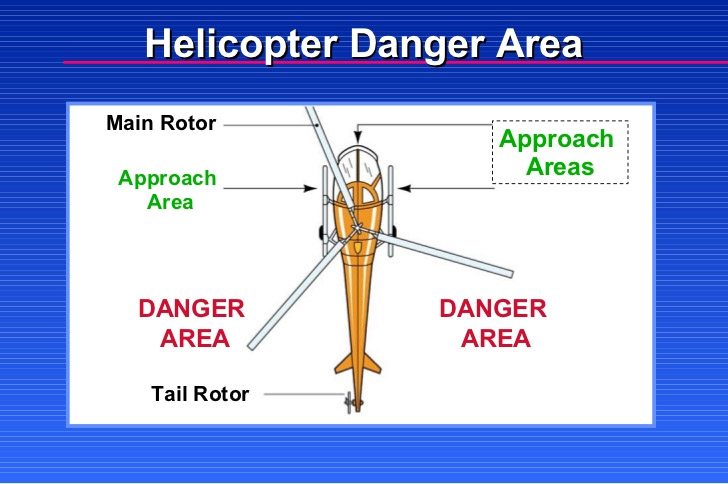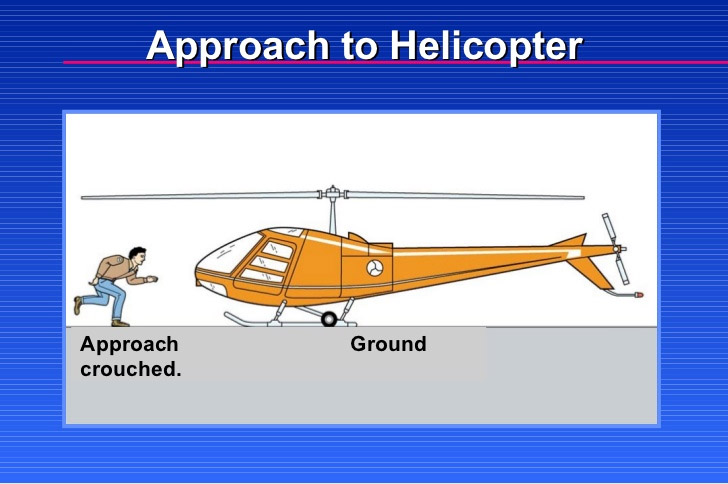Helicopters are one of the most useful assets available to assist search and rescue work. It is important that trip leaders have a good understanding of operating and safety procedures when working with these aircraft.
There are specific safety-related operational procedures used to ensure safety which must be understood and followed by all people when involved with helicopters in any role. These are summarised below.
Landing, take off and winching operations
- The landing area selected should be approximately 7m by 7m, as flat as possible, and well away from power lines, trees or other obstructions that could make the helicopter’s approach to the area hazardous. Dead trees or trees with large, dead branches are a significant hazard to both the helicopter and people on the ground.
- Remove any loose branches, protruding sticks or anything else which could interfere with the helicopter’s landing. There is extremely strong downdraft from the main rotor and side wind from the tail rotor.
- For safety, people should stay at least 50 m away from landing and departing helicopters.
- Secure all gear, hats, skis etc. as the downdraft will be very strong. Even fully loaded packs can be blown around.
- If directing a helicopter pilot for landing, stand on the upwind side of the selected landing area with your arms outstretched indicating the landing area.
- If a helicopter is going to use its winch, a crewman will be lowered to manage things on the ground. As for landing, stay a long way back from any hovering or winching helicopter and secure all gear.
Travelling in a helicopter
Upon entering a helicopter follow directions from the crew. Move to your seat, fasten your seat belt and adjust it as necessary. Keep your seat belt fastened at all times until the pilot or crew signals to you that it is safe to leave the helicopter.
Grounded or hovering helicopter
- Do not approach or leave without the pilot’s knowledge and all-clear signal, which is usually indicated by a ‘thumbs up’ signal, or at night by a flash of landing lights.
- Always approach or depart from the front of the helicopter and remain in the pilot’s field of vision.
- If the helicopter is on a slope, approach and depart on the downhill side to increase rotor clearance.
- Personnel approaching a helicopter must keep their heads down at all times. On windy days the rotors can flap about and the slower the rotor is moving the lower it can dip.
- Do not wear hats or other articles of clothing that can be blown away.
- Never reach up or chase articles blown about.
- Protect eyes. If blinded by dust, grit, snow, etc. crouch or sit down and wait for assistance.
- Never go near the tail area. The tail rotor is often not visible due to its high speed. Never stoop or walk under the tail boom.
- Carry stretchers, skis and or other equipment parallel to the ground and below waist height. Keep a firm grip on all items that could be caught by the strong downdraft from the rotors.



Aircraft searching for someone else
If light aircraft or helicopters are conducting operations which do not involve the group, do not wave or attract the attention of the aircraft. If the helicopter crew has seen the group, it may circle several times and may drop a message pad with instructions or questions such as ‘Please raise hands if you have seen a group of one male adult and two children? If so, please point in direction last seen.’.
It is not always possible for a helicopter to land, even if the ground is clear. The landing and take-off capabilities of a helicopter are affected by such factors as fuel weight, altitude, temperature, wind strength, and number of personnel on board.
If a bushwalking group has information that may be relevant to a search that is apparently underway call Triple Zero (000) and ask for Police.
Aircraft searching for your group
Observers in search aircraft have a very challenging job to locate a missing person amongst rocks and vegetation from a moving aircraft. Technology such as infrared cameras and night vision goggles can assist, but locating people remains a challenge. For example, rocks heat up during the day and there are other warm blooded animals in the bush.
To attract the attention of searching aircraft:
- Place large, brightly-coloured material out in an open area
- Light a smoky fire during the day
- Wave brightly-coloured material
- Reflect the sun’s rays with a mirror.
- At night, set a brightly flaming fire.
- Shining a torch (the aircraft crew see this using night vision equipment).
Do not assume that a searching aircraft has spotted you. Even if illuminated by the aircraft’s search light, or if the aircraft circles, you may not have been observed.
Remember
While a helicopters are very valuable for search and rescue activities, weather conditions can restrict their operation or one may not be available.
Whenever working in and around helicopters, take things slowly, think, and watch the pilot and the crew for hand signals or instructions. Keep your head down and follow their instructions exactly!

